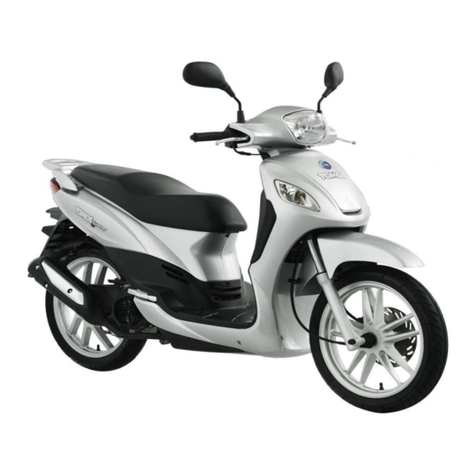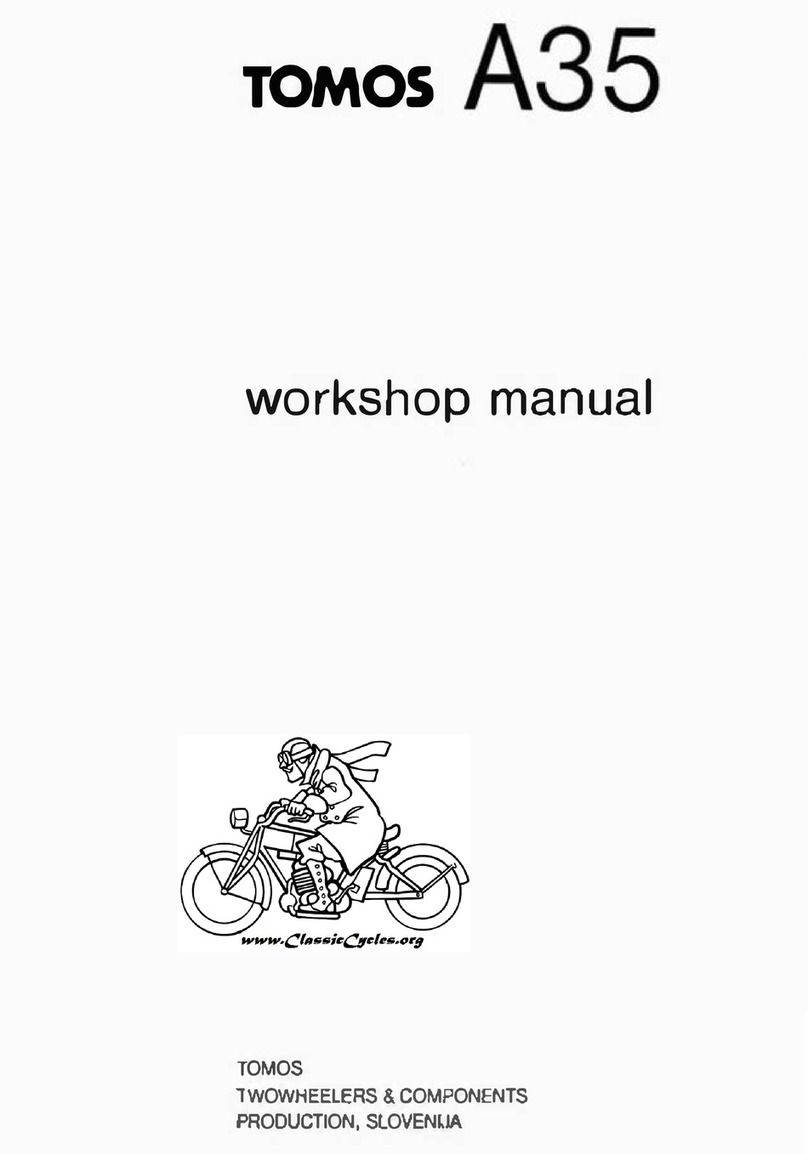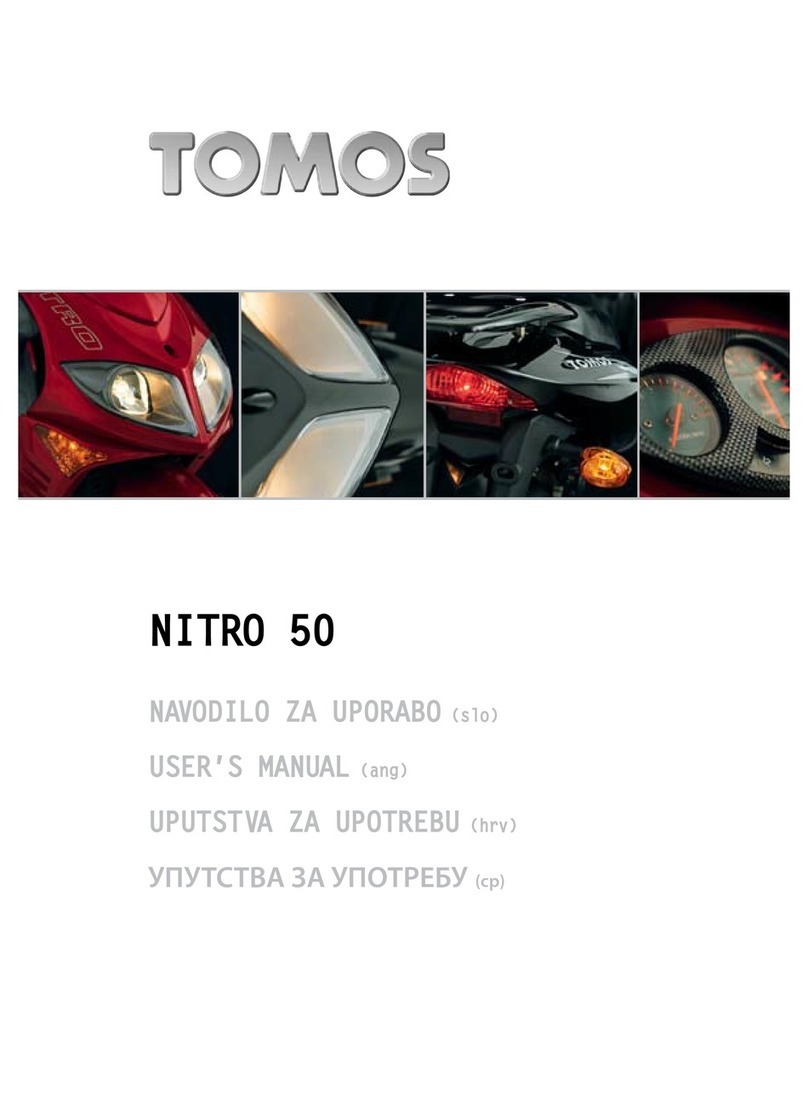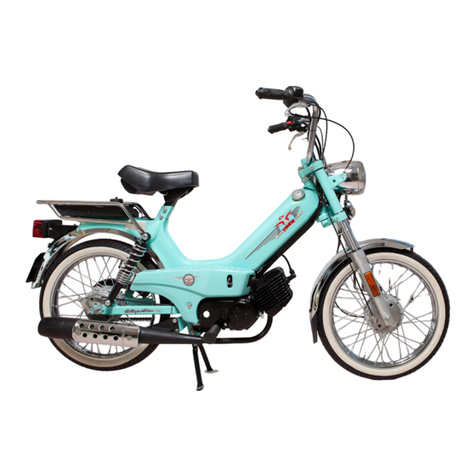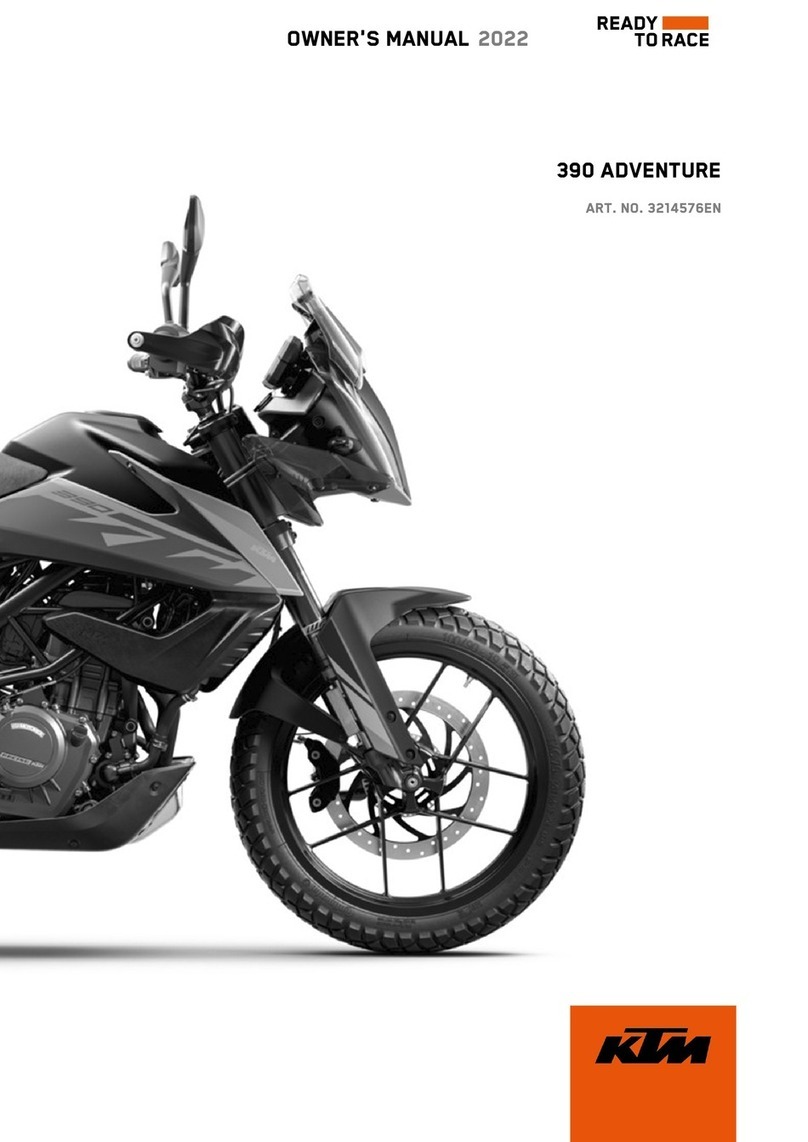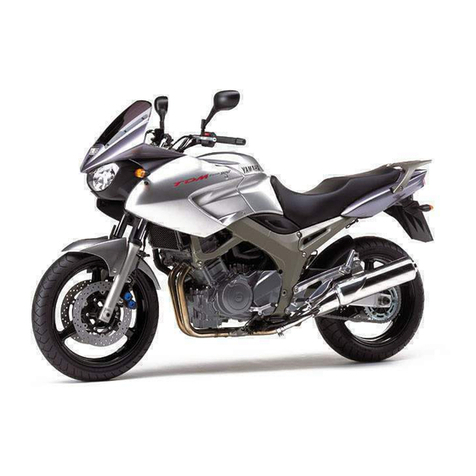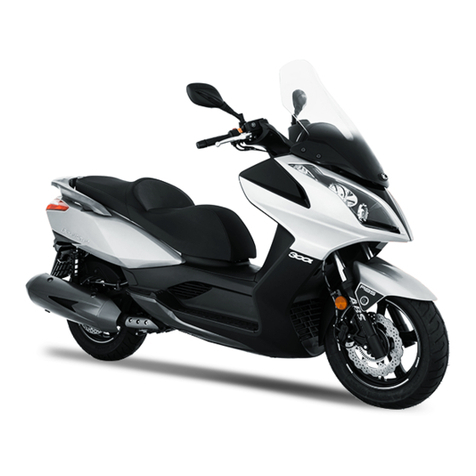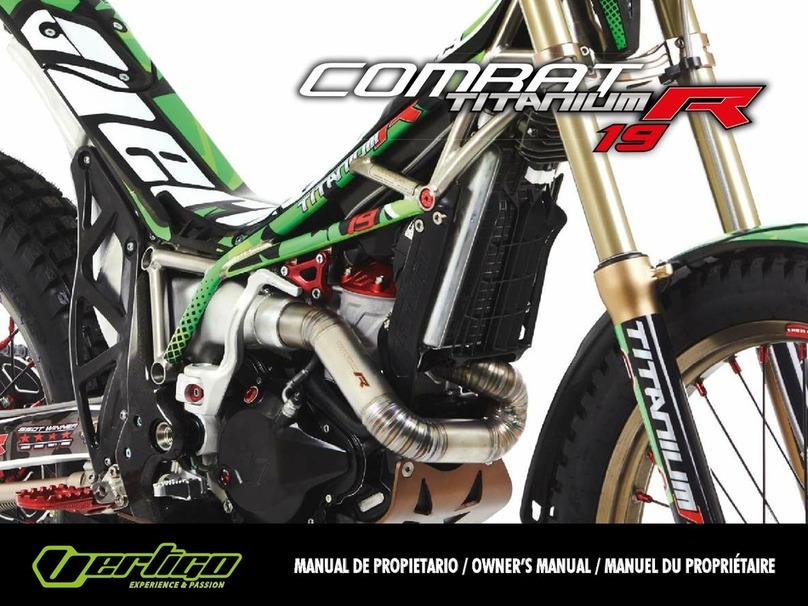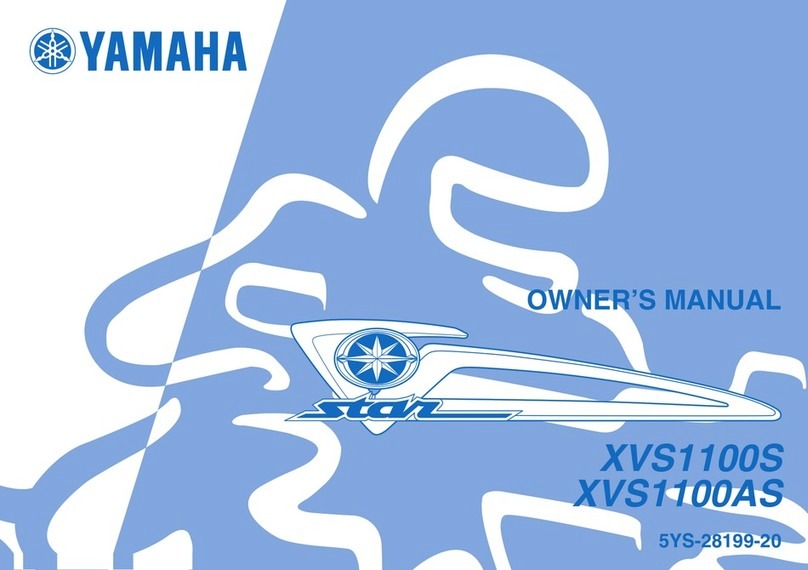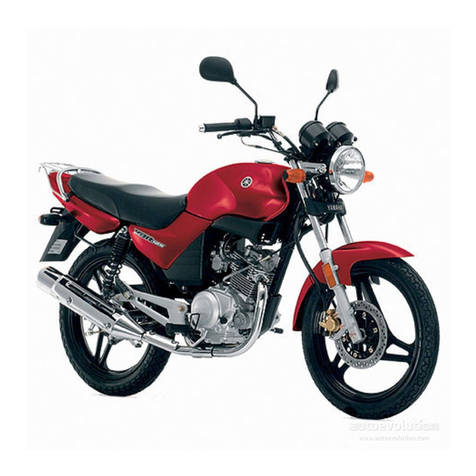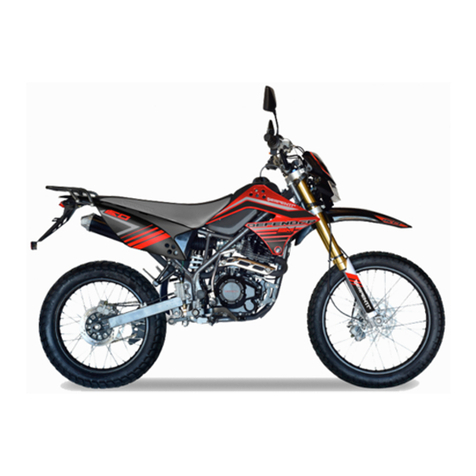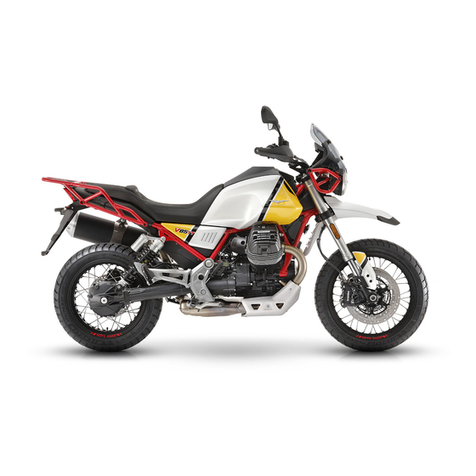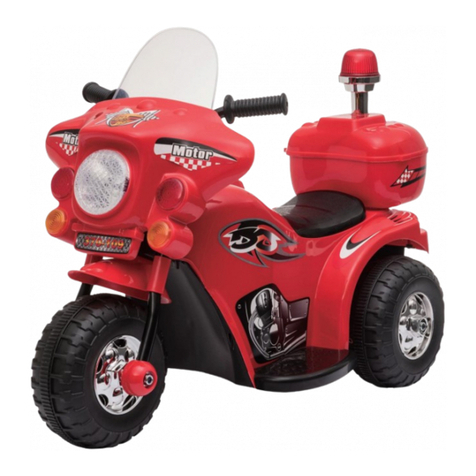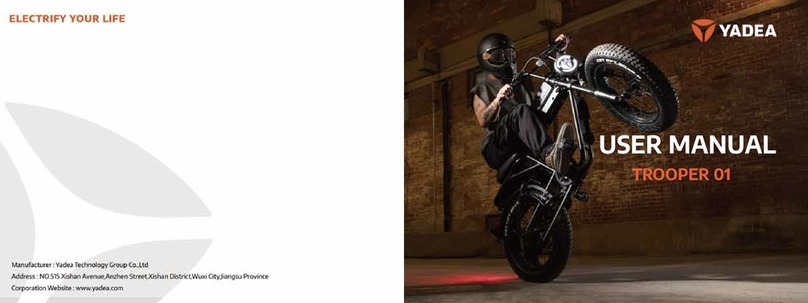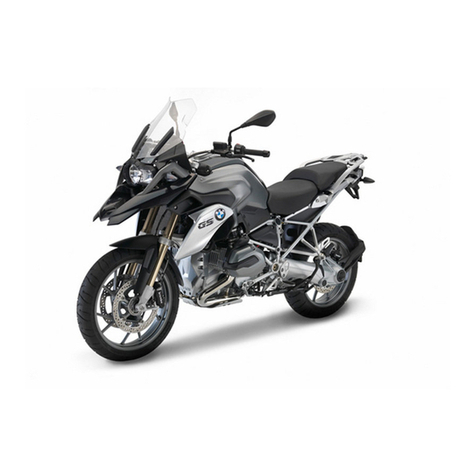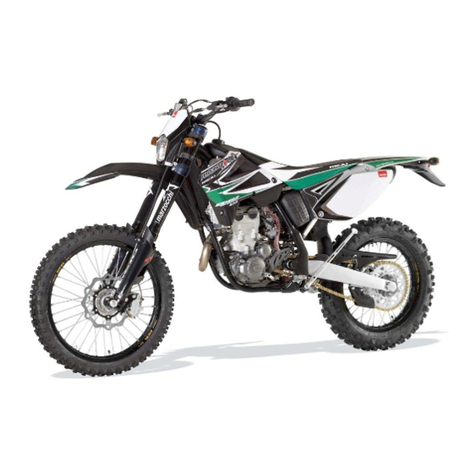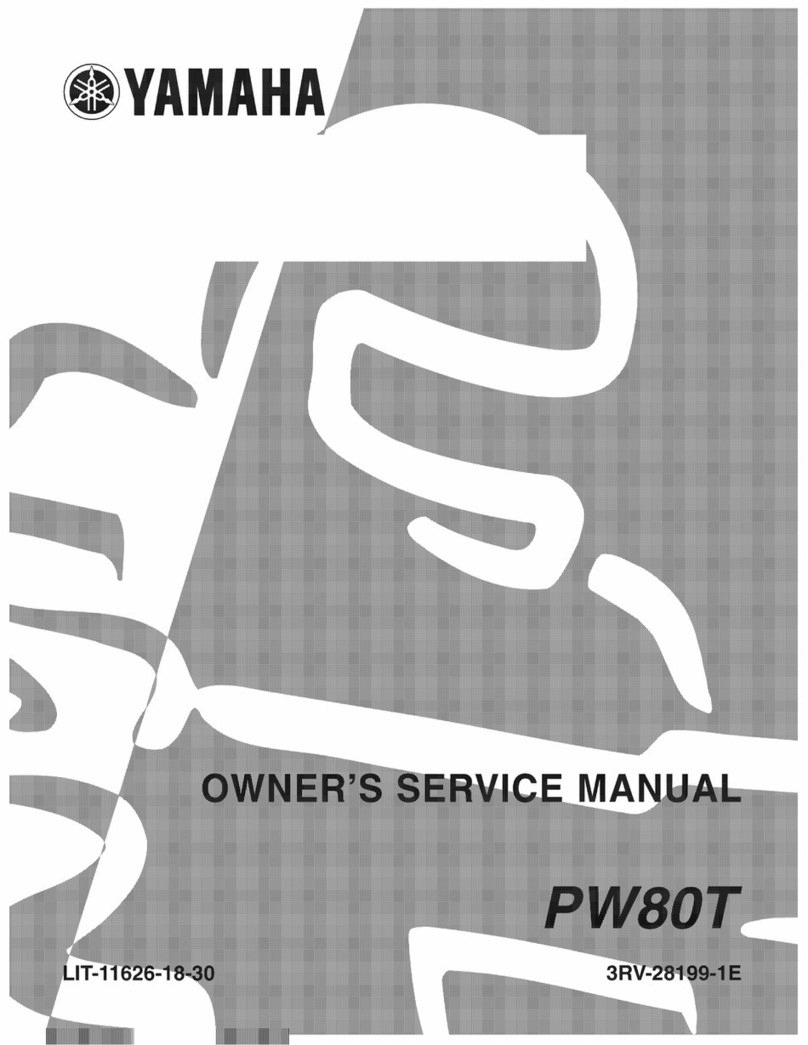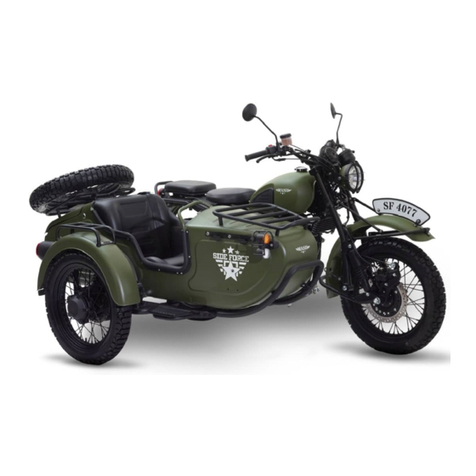Tomos A31988 Instruction manual

1
Tomos A3 1988 Workshop Manual
CONTENTS
Technical Data ………………………………………………………………………………………………………………………………………..2
Nuts, Bolts, and Torque Specs …………………………………..…………………………………………………………………………..3
Special Tools……………………………………………………………………………………………………………………………………………3
Image..……………………………………………………………………………………………………….………………….….……….4
Engine Removal…………………………………………………………………………………………………….…………………………..……5
Engine Disassembly…………………………….……………………………………………………………….…………………………….…..8
Checking Engine Parts and Assemblies ………………………………………………………………………………………………..11
Checking, Dismantling, and Assembling of the Clutch ……………………………………………………….………………..13
Dismantling, Checking, and Assembling of the Countershaft ………………………….…………………………………..15
Checking Pedal Shaft and Transmission Chain .……………………………………………………………………………….……17
Carburetor Checking……………………………………………………………………..………………………………………………………18
Encarwi Image………………………………………………………..………………………………………………………………..18
Dellorto Image……………………………………………………………………………………………………………………….…19
Reassembling the Engine .……………………………….………………………………………………….……………………………….20
Adjusting the Contact Gap and Ignition Advance ……………………….……………………………………………………….23
Oil Pump……………………………………………………………………………………………………………………………………………….24
Magneto Settings and Electrical Equipment…………………………………….…………………………………………..……..25
Wiring Diagrams (COLOR!)
European without turn signals………………………………………………………………………………………………….26
European with turn signals……………………………………………………………………………………………………….27
U.S. without turn signals…………………………………………………………………………………………………………..28
U.S. with turn signals………………………………………………………………………………………………………….…….29
The following is a modified and English-only version of the A3 manual found at www.classiccycles.org
Please note that this version is NOT guaranteed to be a perfect reproduction of the original; if you have
any doubts as to what you are reading, please check the original to be sure.

Classic Cycles Technical Resources
2
TECHNICAL DATA
Engine
Single cylinder, two stroke, air cooled
Bore x stroke
38 x 43 mm (1.496 x 1.693 in)
Piston displacement
49 cm3(2.990 in3)
Compression ratio
8.5 : 1
Engine output
0.75 -1.5 KW
Gear box
automatic 2-steps, with two centrifugal clutches
Ignition
Flywheel magneto
Ignition advance
1.8-2 mm B.T.D.C.
Contact breaker gap
0.35-0.45 mm (0.014-0.018 inches)
Spark plug gap
0.5 mm (0.020 inches)
Spark plug
NGK B6HS, Champion L86, Bosch W 4 AC
Fuel
Mixture of 86 octane gasoline and two stroke oil (2%, or 50:1)
Gearbox oil/ quantity
Valvomatic type A Suffix A – SAE 10W30 / 220 cm3
Front tire pressure
21 psi
Rear tire pressure
31 psi
Gearbox ratio (I)
17: 74, i = 4.3352
Gearbox ratio (II)
26: 64, i = 2.462
Main shaft
11: 71, i = 6.455
Secondary transmission
chain 90-93 rollers, i = 0.846 – 0.923
Crankshaft out-of-round deflection
max 0.01-0.02 mm
Magneto flywheel deflection
max aksialno 0.1mm
max radialno 0.3mm
Clutch drum axial play
0.1-0.3 mm

3
NUTS, BOLTS, AND TORQUE SPECIFICATIONS
Part
Thread
Torque
Spark plug
M14 x 1.25
18Nm
Cylinder cover
M7
12Nm
Flywheel
M10
30Nm
1st speed clutch
M10 x 1
25Nm
2nd speed driven gear
M14 x 1
80Nm
Mainshaft chain sprocket
M22
60Nm
Cylinder stud bolts
M7
15Nm
Crankcase
M6
10Nm
LH engine cover
M6
6Nm
RH engine cover
M6
7Nm
Engine-frame fastening screws
M8 x 1
25Nm
Swingarm fastening screw
M12 x 1.25
35Nm
Rear shock
M10
25Nm
Top fork lug
M12
35Nm
Front and rear wheel spindle
M11 x 1
32Nm
SPECIAL TOOLS
011.008
Gauge pin
702.856
Crankshaft bearings fitting tool
708.253
Connecting rod bush pulling key
714.011
Repair stand
731.155
Crankshaft bearings puller
731.798
Clutch spring fitting tool
732.193
Dial gauge support tool
732.202
Flywheel and clutch holding tool
732.268
Roller clutch installer
732.746
Iskra flywheel puller
735.753
Fork
735.888
Case splitter
736.533
CEV flywheel puller
737.080
Centering pin
975.709
Dial gauge

Classic Cycles Technical Resources
4

5
ENGINE REMOVAL
Drain the oil from the gearbox (fig 1)
Unscrew the footrest screw with 17mm wrench
(fig 2)
With 11mm wrench, unscrew the nut and drive
out lever pin (fig 3)
For pedal versions, refer to figures 3a and 4a
Remove the hub, cups and springs (fig 4)
Unscrew the three screws of LH and RH shield
each and detach shields from frame (fig 5)

Classic Cycles Technical Resources
6
Unscrew three screws of magneto cover and
detach cover (fig 6)
For oil pump injection refer to chapter OIL PUMP
Remove the chain by removing master link (fig 7)
Unscrew the crown nut and extract control cable
along with throttle piston (fig 8)
Unscrew bottom screw on control cable cover and
release the spark plug cable (fig 9)
Detach all electrical leads (fig 10)
Remove fuel supply line. Remove the two exhaust
manifold bolts, the fixing screw, and remove the
exhaust silencer (fig 11)

7
Unscrew all three engine screws with two 13mm
wrenches (fig 12)
Hold the engine by hand. Extract top screw (3) and
remove the engine out of the frame (fig 13)
Take the intake silencer out of the frame (fig 14)

Classic Cycles Technical Resources
8
ENGINE DISASSEMBLY
Place the engine on the repair stand (special tool).
Remove the carburetor and spark plug (fig 15)
Detach clutch drum and sintered bush (fig 18)
The pedal shaft and the countershaft are
connected by a starter chain, so both shafts will
have to be taken out together (fig 19)
Remove the standard washers on the crankshaft
and on the mainshaft (fig 20)
Rotate the engine placed on the stand so that the
flywheel magneto is on top. Using the flywheel
and clutch holding tool to hold the flywheel, use a
17mm socket to remove the flywheel nut (fig 21)

9
The flywheel is removed with the flywheel puller,
a 19mm, and a 32mm wrench (fig 22)
Make a scriber mark across the bottom of the
stator plate and the crankcase in order to facilitate
the re-timing. Remove the 3 screws and lift the
stator assembly from the engine (fig 23)
Slacken the chain sprocket nut. Using the flywheel
and clutch holder tool and a 30mm wrench,
remove the sprocket nut (fig 24)
Using an 11mm socket, unscrew the 4 cylinder
head nuts. Remove the washers, cylinder head,
cylinder, and base gasket (fig 25)
With pointed nose pliers, remove the gudgeon pin
spring circlips (fig 26)
Press out the gudgeon pin and remove the piston
(fig 27)

Classic Cycles Technical Resources
10
If the brass bushing in connecting rod needs to be
replaced, use the connecting rod bush pulling key,
and replace with a new one using same tool (fig 28)
Upon installing the new bushing, drill two
lubrication holes according to the holes in the
connecting rod.
The bush as a spare part has inner diameter 9.80
+/- 0.1 mm and it is necessary to ream it out to
increase the inner diameter to 10mm.
Remove the crankshaft and gasket and knock out
the mainshaft (fig 31)
In case the crankshaft ball bearing remains in the
RH crankcase, use the crankshaft bearings fitting
tool (fig 32)
If the ball bearing remains on the crankshaft, use
the crankshaft bearings puller (fig 33)
The mainshaft sealing ring and ball bearing are
pressed out by using a suitable socket (fig 34)

11
CHECKING ENGINE PARTS AND ASSEMBLIES
Check both crankcase halves for possible damages or distortions, particularly the joint surfaces, to avoid
later leaking of oil from the gearbox.
Check all bearings. If clearance is noticed, the bearings must be replaced.
Check the crankshaft between the center of a horizontal alignment tool and measure out-of-round on all
the points indicated in figure 35.
Permissible out-of-round should be within 0.01 mm at check pints 2 and 3 and 0.02 mm at check points
1 and 4. Check if the crankshaft conical part is damaged, inspect the thread on semiaxles and the
keyway.
Check piston surfaces for possible damages. With micrometer check piston diameter on points d1, d2,
d3 and d4 at right angles to gudgeon pin and compare the reading with the corresponding group on
piston and in the table (fig 36)
Figure 35
Figure 36

Classic Cycles Technical Resources
12
CYLINDER
D (mm, in)
A
B
38.01 +0.01 (1.4964 +0.0024 in)
38.02 +0.01 (1.4968 +0.0024 in)
D > D1max 0.012 mm
Ma x permissible bore taper: 0.006mm
PISTON
D1
D2
D3
D4
A
37.95 +0.01
37.91 +0.01
37.87 +0.01
37.85 +0.01
B
37.96 +0.01
37.92 +0.01
37.88 +0.01
37.86 +0.01
L = 50 mm
L= 52.5 mm
L = 55 mm
Piston I. oversize: Ø 38.50mm
The cylinder must be bored and honed as shown in the table:
OVERSIZE CYLINDER
D (mm, in)
A
B
38.51 +0.01
38.52 +0.01

13
CHECKING, DISMANTLING, AND ASSEMBLING OF THE CLUTCH
Remove the circlip and separate the 1st and 2nd
speed clutches (fig 37)
Dismantle both clutches. The spring is removed
with a screwdriver (fig 38)
In this manner, brake strips are released, and all
three shoes can be removed (fig 39)
Press pins out of shoes and check brake strips,
spring inside of shoes and 2nd speed clutch gear. At
first, assemble the 1st speed clutch as reversed
order of dismantling. Particular care should be
taken of brake shoes; they must protect each
other from falling out (fig 40)
Fix the main pin of the clutch spring fitting tool
with the thinner part facing upwards. The spring
joint must be placed in the middle of one shoe.
With the lever of the device, insert the spring into
the shoes groove (fig 41)
To assemble the 2nd speed clutch, turn the device
over. The clutch hub with gear must be placed in
the way the gear is on the bottom and the gap
between the two shoes fits with the pin. The
manner of mounting the spring is the same as
mentioned before for the 1st speed clutch (fig 42)

Classic Cycles Technical Resources
14
Dismantling of the needle clutch is necessary only in case of replacement. A new needle clutch is
pressed with special tool “roller clutch installer.” The needle clutch must be pushed with the signed side
towards the center of the clutch drum, or else it may operate in the reverse direction (fig 43)

15
DISMANTLING, CHECKING, AND ASSEMBLING OF THE COUNTERSHAFT
Fix the countershaft into a vice and unscrew the
nut with a 19mm wrench (fig 44)
Remove the 2nd speed gear (fig 45)
Remove the circlip at the shaft’s toothing (fig 46)
Unfasten the wire spring and separate a small
chain sprocket with roller cage (fig 47)
Remove the 1st speed gear and shake the rollers
out (fig 48)
If troubles appear in the self-locking clutch,
consisting of rollers with 1st speed gear hub,
possible damage of the countershaft may be
repaired by grinding the bearing surface for
0.1mm at the most. When most rollers make small
hollows in the hub, the latter can be honed. If
hollows are rather large, the gear should be
replaced.

Classic Cycles Technical Resources
16
Reassemble the countershaft in reverse order of
dismantling.
Use of grease is not suggested because it may
impede the function of the self-locking clutch.
Put the chain sprocket in with cage so that the
beginning of the wire spring is turned 90 degrees
left-ward from the spring nose (fig 49). Lock the
wire spring to riveted nose on the 1st speed gear

17
CHECKING PEDAL SHAFT (kickstart) AND TRANSMISSION CHAIN
If it is necessary to replace the chain sprocket or claw collar on the pedal shaft or kick start, first rmove
the protective ring (fig 50/1) and the spring washer (fig 50/2). During assembly, take care that the
thinner part of the collar is mounted forward or else the brake spring will slide across the chain
sprocket. Check the chain for overtensioning or other damage. In case of damage, the needle bearings
in the main shaft should be replaced with a new complete main shaft (fig 51)

Classic Cycles Technical Resources
18
CARBURETOR CHECKING
Dismantle the carburetor into component parts (fig 52 Encarwi or 52a Dellorto). Clean the parts with
carb cleaner and blow them out with compressed air. Check the parts. In case of wear throttle slide or
leakage of float, replace with a new one. When reassembling the carburetor, take care that the float
needle fits the float chamber cover. Slightly oil the air filter with light oil.
FIGURE 52 – ENCARWI CARBURETOR

19
FIGURE 52a – DELLORTO CARBURETOR

Classic Cycles Technical Resources
20
REASSEMBLING THE ENGINE
When reassembling the engine, replace all seals
and gaskets. All parts of the engine should be
thoroughly cleaned and lightly oiled. All gaskets
should be given a light coat of grease to insure
better fit and seal.
With the crankshaft bearings fitting tool, press the
crankshaft ball bearings into both crankcase halves
(fig 53)
Insert the crankshaft into the LH half of the
crankcase using the splitter. Through the splitter,
screw the device on the crankshaft. With an 11mm
and a 24mm wrench, place the crankshaft in the
crankcase (fit 54)
Place the mainshaft and a washer on the
mainshaft needle bearing. Insert the fork between
the two halves of the crankshaft (fig 55)
Join the right crankcase with the left one, acting as
follows: (1) Press the two crankcases by hand and
then lightly tap them together with a mallet
(2) Insert the 6 screws in the inner holes and 2 in
the outer holes. Slowly tighten the screws (fig 56)
With the crankshaft bearings fitting tool, insert
both crankshaft seal rings.
WARNING: The LH carter seal ring is facing
towards the connecting rod, while the RH side is
opposite.
Table of contents
Other Tomos Motorcycle manuals

